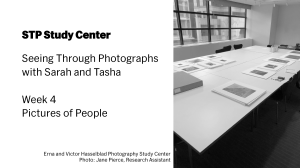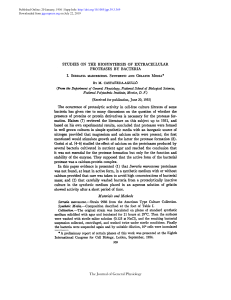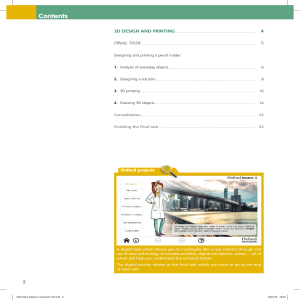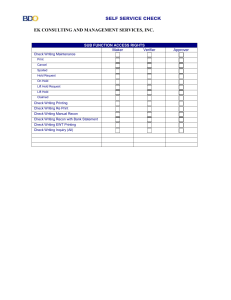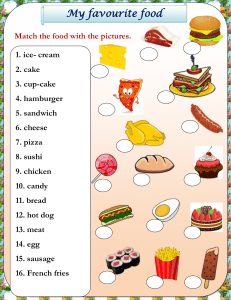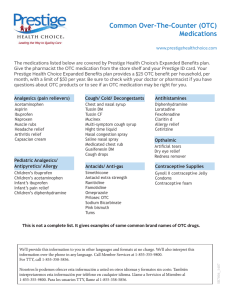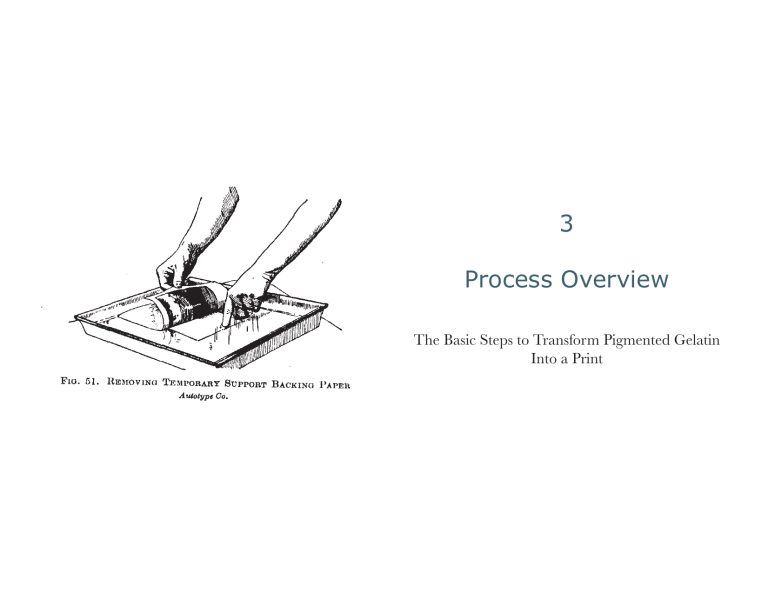
3 Process Overview The Basic Steps to Transform Pigmented Gelatin Into a Print C Process Overview arbon transfer is a contact printing process that produces an image formed by a layer of hardened, pigmented gelatin on a surface which is usually paper. The surface on which the image is printed is generically referred to as the “support” because carbon images can be printed on a variety of surfaces such as glass, metal, and synthetic paper sheets, in addition to a variety of types of natural paper. The process has traditionally gone by the name “carbon” because the original and most common pigment was carbon black which is manufactured from carbon soot. However, in practice, a wide variety of pigments are used. Accordingly, the process could be more accurately referred to as “pigment transfer.” The term “transfer” refers to the transfer of the pigmented gelatin from a temporary support to another support surface on which the image is developed. The transfer procedure was patented by Swan in 1864 and was the major innovation that led to carbon printing as we know it today. There are some lesser known direct carbon processes such as Fresson in which no transfer of the pigmented gelatin takes place. The making of a carbon print begins with a sheet of “carbon tissue.” The tissue is a smooth layer of pigmented gelatin coated and dried on a sheet of flexible material. The use of the term “tissue” is an anachronism which probably has its origin in the fact that the paper backing of the material was disposed of, like a tissue, after use. The carbon tissue is made light sensitive by coating it with a solution of dichromate which it absorbs. When dry, a negative of the same size as the final print is placed in contact with the sensitized carbon tissue, and exposed with a light source rich in UV light. This causes the gelatin to harden directly in proportion to negative densities, i.e. the tissue is hardened more in the shadows than in the highlights. In figures A and B, this diagram of the single transfer process shows the relationship between negative densities and the hardening of the pigmented gelatin from the surface of the tissue downward. In figure C, the surface of the tissue is mated with the final support. In the development bath, the temporary support is stripped away and the soluble gelatin is allowed to dissolve, leaving the carbon relief on the final support as shown in figure D. After exposure the tissue is soaked briefly in cool water, then squeegeed into contact with another support, usually paper. The sandwich of tissue and support is allowed to rest for about 30 minutes. The sandwich is then transferred to a tray of water at about 104° Fahrenheit (40° 18 Process Overview Celsius) for development. Once the pigmented gelatin has begun to melt the tissue is peeled from the support and discarded. The unhardened gelatin slowly washes away from the support leaving the relief image. The carbon relief is then allowed to dry. In the process referred to as “single transfer” the carbon relief is on its final support after the first transfer and the print is complete. In the “double transfer” process, the carbon relief is transferred a second time to its final support. Double transfer is used to reverse the horizontal orientation of the image or in procedures involving multi-layered prints. Once the carbon relief is on it’s final support it is allowed to dry, residual dichromate is cleared from the print, and it is ready to be prepared for presentation. In summary, the major steps in making a carbon print are: 1. Make carbon printing tissues and prepare final supports. 2. Sensitize the tissue with a dichromate solution and allow it to dry. 3. Expose the sensitized carbon tissue by contact printing it with a negative using a light source rich in ultraviolet light. 4. After exposure, soak the exposed carbon tissue in water and then squeegee the tissue onto a paper or other suitable support. Cover the sandwich of tissue and support with a sheet of glass, and leave it undisturbed for about 20-30 minutes. 5. Transfer the sandwich of tissue and support to a tray of warm water and develop the relief by washing away the insoluble gelatin. This is the final step for single transfer. 6. For double transfer, allow the image on the temporary plastic support to dry and then transfer it a second time to its final support. Sidewalk. Philip Schwartz. Carbon print 19
